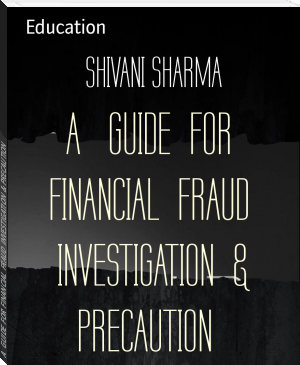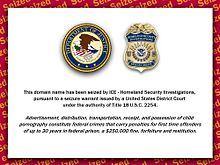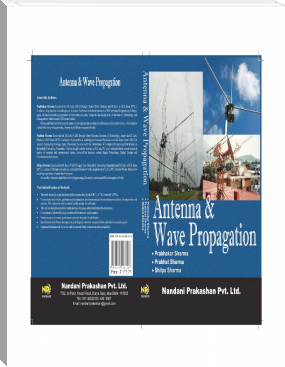A GUIDE FOR FINANCIAL FRAUD INVESTIGATION & PRECAUTION, SHIVANI SHARMA [read my book txt] 📗

- Author: SHIVANI SHARMA
Book online «A GUIDE FOR FINANCIAL FRAUD INVESTIGATION & PRECAUTION, SHIVANI SHARMA [read my book txt] 📗». Author SHIVANI SHARMA
Laws regarding child pornography generally include sexual images involving prepubescents, pubescent or post-pubescent minors and computer-generated images that appear to involve them.[19] Most possessors of child pornography who are arrested are found to possess images of prepubescent children; possessors of pornographic images of post-pubescent minors are less likely to be prosecuted, even though those images also fall within the statutes.[19]
Producers of child pornography try to avoid prosecution by distributing their material across national borders, though this issue is increasingly being addressed with regular arrests of suspects from a number of countries occurring over the last few years.[19][20] The prepubescent pornography is viewed and collected by pedophiles for a variety of purposes, ranging from private sexual uses, trading with other pedophiles, preparing children for sexual abuse as part of the process known as "child grooming", or enticement leading to entrapment for sexual exploitation such as production of new child pornography or child prostitution.[21][22][23] Children themselves also sometimes produce child pornography on their own initiative or by the coercion of an adult.[24]
Child pornography is illegal and censored in most jurisdictions in the world.[25][26] Ninety-four of 187 Interpol member states had laws specifically addressing child pornography as of 2008, though this does not include nations that ban all pornography.[27] Of those 94 countries, 58 criminalized possession of child pornography regardless of intent to distribute.[27] Both distribution and possession are now criminal offenses in almost all Western countries. A wide movement is working to globalize the criminalization of child pornography, including major international organizations such as the United Nations and the European Commission.
Terminology Warning Banner for Operation Protect Our Children
Warning Banner for Operation Protect Our Children
In the 2000s, use of the term child abuse images increased by both scholars and law enforcement personnel because the term "pornography" can carry the inaccurate implication of consent and create distance from the abusive nature of the material.[8][9][10][29][30] A similar term, child sexual abuse material, is used by some official bodies,[31][32][33] and similar terms such as "child abuse material", "documented child sexual abuse", and "depicted child sexual abuse" are also used, as are the acronyms CAM and CAI.[29] The term "child pornography" retains its legal definitions in various jurisdictions, along with related terms such as "indecent photographs of a child" and others.[8][9][10][34] In 2008, the World Congress III against the Sexual Exploitation of Children and Adolescents stated in their formally adopted pact that "Increasingly the term 'child abuse images' is being used to refer to the sexual exploitation of children and adolescents in pornography. This is to reflect the seriousness of the phenomenon and to emphasize that pornographic images of children are in fact records of a crime being committed."[35]
Interpol and policing institutions of various governments, including among others the United States Department of Justice, enforce child pornography laws internationally.[19] Since 1999, the Interpol Standing Working Group on Offenses Against Minors has used the following definition:
Child pornography is the consequence of the exploitation or sexual abuse perpetrated against a child. It can be defined as any means of depicting or promoting sexual abuse of a child, including print and/or audio, centered on sex acts or the genital organs of children.[12]
Child sexual abuse in production and distribution
Children of all ages, including infants,[36] are abused in the production of pornography.[4][19] The United States Department of Justice estimates that pornographers have recorded the abuse of more than one million children in the United States alone.[37] There is an increasing trend towards younger victims and greater brutality; according to Flint Waters, an investigator with the federal Internet Crimes Against Children Task Force, "These guys are raping infants and toddlers. You can hear the child crying, pleading for help in the video. It is horrendous."[38] According to the World Congress against Commercial Sexual Exploitation of Children, "While impossible to obtain accurate data, a perusal of the child pornography readily available on the international market indicates that a significant number of children are being sexually exploited through this medium."[39]
The United Kingdom children's charity NCH has stated that demand for child pornography on the Internet has led to an increase in sex abuse cases, due to an increase in the number of children abused in the production process.[40] In a study analyzing men arrested for child pornography possession in the United States over a one-year period from 2000 to 2001, 83% had pornographic images of prepubescent children and 80% had images graphically depicting sexual penetration. 21% had images depicting violence such as bondage, rape, or torture and most of those involved images of children who were gagged, bound, blindfolded, or otherwise enduring sadistic sex. 39% had child-pornography videos with motion and sound. 79% also had images of nude or semi-nude children, but only 1% possessed such images alone. Law enforcement found that 48% had more than 100 graphic still images, and 14% had 1,000 or more graphic images. 40% were "dual offenders," who sexually victimized children and possessed child pornography.[14]
A 2007 study in Ireland, undertaken by the Garda Síochána, revealed the most serious content in a sample of over 100 cases involving indecent images of children. In 44% of cases, the most serious images depicted nudity or erotic posing, in 7% they depicted sexual activity between children, in 7% they depicted non-penetrative sexual activity between adults and children, in 37% they depicted penetrative sexual activity between adults and children, and in 5% they depicted sadism or bestiality.[3]
Masha Allen was adopted at age 5[41] from the former Soviet Union by an American man who sexually abused her for five years and posted the pictures on the Internet. She testified before the United States Congress about the anguish she has suffered at the continuing circulation of the pictures of her abuse, to "put a face" on a "sad, abstract, and faceless statistic," and to help pass a law named for her.[42] "Masha's Law," included in the Adam Walsh Child Protection and Safety Act passed in 2006, includes a provision which allows young people 18 and over to sue in civil court those who download pornographic images taken of them when they were children.[43] "Downloading" includes viewing without explicitly saving images; many successful prosecutions are completed using residual images left on the viewer's computer.[citation needed]
Relation to child molestation and abuseMain article: Relationship between child pornography and child sexual abuse
Experts differ over any causal link between child pornography and child sexual abuse, with some experts saying that it increases the risk of child sexual abuse,[44] and others saying that use of child pornography reduces the risk of offending.[45][46] A 2008 American review of the use of Internet communication to lure children outlines the possible links to actual behaviour regarding the effects of Internet child pornography.[47]
According to one paper from the Mayo Clinic of the U.S.A. based on case reports of those under treatment, 30% to 80% of individuals who viewed child pornography and 76% of individuals who were arrested for Internet child pornography had molested a child. As the total number of those who view such images can not be ascertained, the ratio of passive viewing to molestation remains unknown. The report also notes that it is not possible to define the progression from computerized child pornography to physical acts against children.[48] Several professors of psychology state that memories of child abuse are maintained as long as visual records exist, are accessed, and are "exploited perversely."[6][11]
A study by Wolak, Finkelhor, and Mitchell states that "rates of child sexual abuse have declined substantially since the mid-1990s, a time period that corresponds to the spread of CP online. . . . The fact that this trend is revealed in multiple sources tends to undermine arguments that it is because of reduced reporting or changes in investigatory or statistical procedures. . . . [T]o date, there has not been a spike in the rate of child sexual abuse that corresponds with the apparent expansion of online CP."[49]
TypologyFurther information: COPINE scale
In the late 1990s, the COPINE project ("Combating Paedophile Information Networks in Europe") at University College Cork, in cooperation with the Paedophile Unit of the London Metropolitan Police, developed a typology to categorize child abuse images for use in both research and law enforcement.[34] The ten-level typology was based on analysis of images available on websites and internet newsgroups. Other researchers have adopted similar ten-level scales.[50] In 2002 in the UK, the Sentencing Advisory Panel adapted the COPINE scale to five levels and recommended its adoption for sentencing guidelines, omitting levels 1 to 3 and recommending that levels 4 to 6 combine as sentencing level 1 and that the four levels from 7 to 10 each form an individual severity level, for a total of 5 sentencing stages.[34]
The COPINE Scale 1 Indicative Non-erotic and non-sexualised pictures showing children in their underwear, swimming costumes from either commercial sources or family albums. Pictures of children playing in normal settings, in which the context or organisation of pictures by the collector indicates inappropriateness. 2 Nudist Pictures of naked or semi-naked children in appropriate nudist settings, and from legitimate sources. 3 Erotica Surreptitiously taken photographs of children in play areas or other safe environments showing either underwear or varying degrees of nakedness. 4 Posing Deliberately posed pictures of children fully clothed, partially clothed or naked (where the amount, context and organization suggests sexual interest). 5 Erotic Posing Deliberately posed pictures of fully, partially clothed or naked children in sexualised or provocative poses. 6 Explicit Erotic Posing Pictures emphasising genital areas, where the child is either naked, partially clothed or fully clothed. 7 Explicit Sexual Activity Pictures that depict touching, mutual and self-masturbation, oral sex and intercourse by a child, not involving an adult. 8 Assault Pictures of children being subject to a sexual assault, involving digital touching, involving an adult. 9 Gross Assault Grossly obscene




Comments (0)